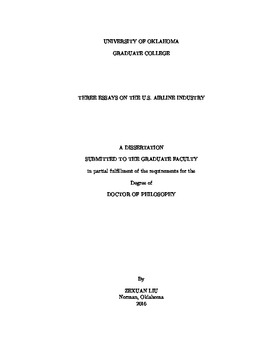| dc.description.abstract | My research uses cutting-edge econometric techniques to isolate and identify the impact of various changes in the U.S. airline industry, whether coming from an endogenous change in the market structure such as merger, or coming from a (potentially) exogenous policy change such as the tarmac delay rule. My research is primarily empirical and I have utilized large microeconomic data from the airline industry.
In my first chapter, I use genetic matching and difference-in-difference to estimate the impact of airline merger on vertical and horizontal product differentiation. Different from many industries, airline services can be viewed as networks. Correspondingly, merger can lead to significant network effects, in addition to the commonly claimed synergy (economies of scale). There have been several existing studies trying to link market structure with on-time performance and my paper adds to this literature. The main contributions of our paper are three-folds. First, I focus on one particular merger (between U.S. Airways and America West) and carefully select sample periods to avoid contamination of confounding factors. Second, I use panel matching together with endogenous weights to construct a properly matched group: those that did not experience merger but best resemble the treated group (from merging carriers). Comparing the treated and matched groups allows us to do a proper difference-in-difference estimation to evaluate the impact of merger. Third, and probably most important, while I analyze the impact of merger on arrival delay, I take it one step further by treating arrival delay as one measure of quality (vertical product differentiation). I then introduce several other measures for vertical differentiation as well as horizontal differentiation. To my knowledge, this is the first study of the U.S. airline industry taking this perspective.
To estimate the causal impact of merger, I use panel matching with a difference in difference approach. Maintaining the time series property is important in terms of constructing a properly matched group, especially for the merger case. To address this, I use the genetic algorithm to find the optimal weight for each covariate per time period. Based on the optimal weights, a generalized Mahalanobis distance matrix is created. I construct the matched group by identifying the panels with a minimum distance to the treated panels. Conditional on the balanced covariates, I are able to address the selection issue and then use a diff-in-diff estimation to gauge the impact of merger. Our results show that merger reduces arrival delay (by 0.7 minutes), number of flights per route (by 10.7), number of routes (by 61) and destinations (by 2.8). On the other hand, merger has mostly insignificant impacts on our measures of horizontal differentiation.
My second chapter's topic is motivated by both personal experience and the extensive media coverage about the lengthy tarmac delay. As a response to multiple lengthy tarmac delay cases, U.S. Dept of Transportation (DOT) released a new tarmac delay rule in December 2009. The purpose of the rule is to eliminate the lengthy tarmac delay and protect consumers' rights. Carriers face a severe financial penalty if they fail to provide opportunities for passengers to deplane after a three-hour tarmac delay for domestic flights. This paper aims to examine the impact of the tarmac delay rule, including carriers' responses to the rule.
My third chapter studies the impact of quality uncertainty on flight temporal differentiation. There is an extensive literature studying optimal horizontal product differentiation. It is well documented that when a firm moves its product closer to its rival's product space, there are two opposite effects on the firm's profitability: market share effect which improves profit and competition effect (or price effect) which reduces profit. More recently, Bester (1998) links the impact of quality uncertainty with the pattern of equilibrium horizontal differentiation. Their main finding is that quality uncertainty reduces the intensity of the price effect, resulting in lower horizontal differentiation in the equilibrium.
Using two measures of horizontal differentiation: Time to noon and Gini coefficient, I directly test this hypothesis. After using a novel instrumental variable to correct for endogeneity, I find that higher quality uncertainty is linked to less horizontal differentiation, supporting Bester's theoretical prediction. With higher quality uncertainty, travelers do not view firms' flights as close substitutes even though their departure times may be close. This reduces competition intensity (the price effect). As a result, the market share effect will dominate the price effect and results in an ``aggregation" in terms of horizontal differentiation. | en_US |
